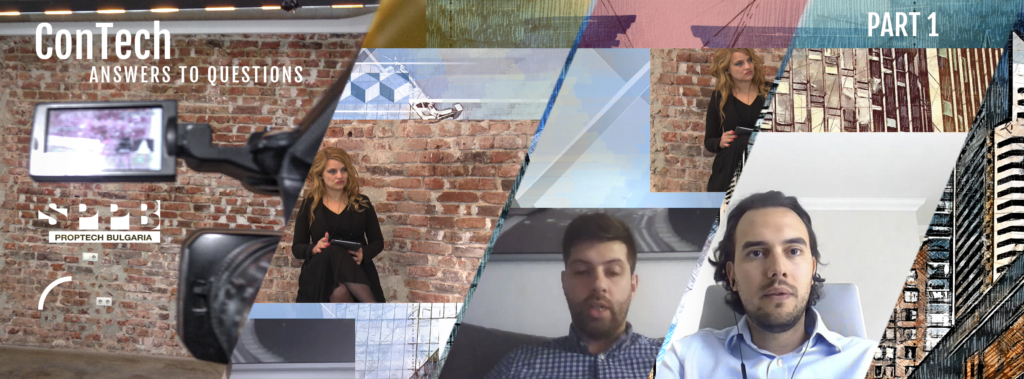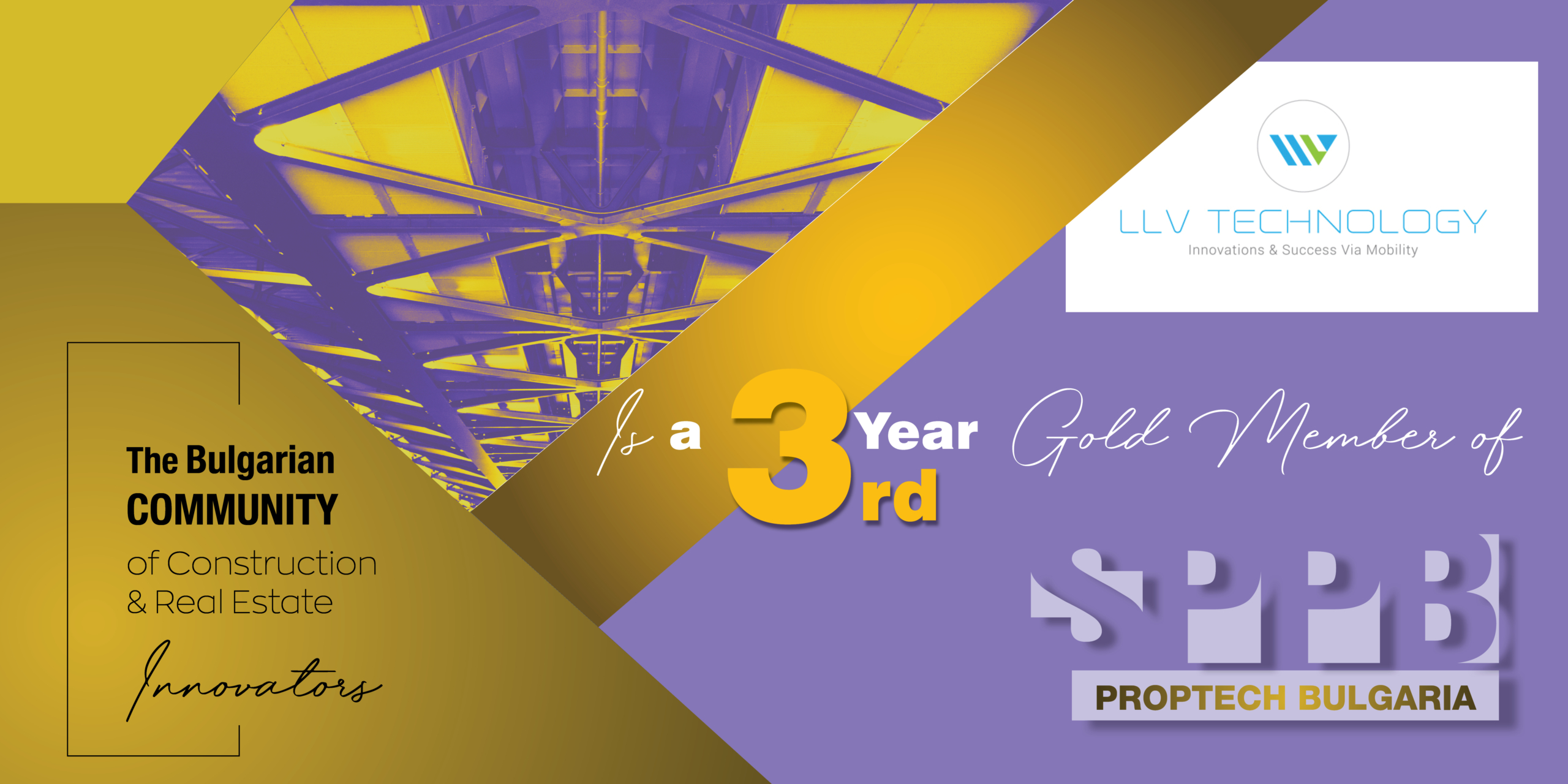CONTECH IN 3 TIME LAYERS: PART 2
> ConTech in 3 time layers: pre-Covid, during the pandemic, and what is ahead of us in the near future
> Future prospects for ConTech solutions that has only a software core, and the ones with a physical product
> Carboncapture ConTechs
We talked with Dr Dimitar Dimov, Founder Concrene Ltd, the UK, and Boris Goldshteyn, Co-Founder and CEO Visoplan GmBH, Germany
The interview is completed by Sylvia Pavlova MBA CMC, Founder PropTech Bulgaria, Co-Founder PrEXCELerator Bulgaria.
This interview was part of the Bulgarian PropTech Business Show on RE:Connect 3.0 on 24 June 2021. Bulgaria was represented by PropTech Bulgaria at RE:Connect 3.0 – one of the largest PropTech events worldwide. This is the 2nd part of our conversation. You can see the other 2 here >
About Dr Dimitar Dimov:
Dr Dimitar Dimov read BEng Civil Engineering followed by a PhD in Nanoscience Engineering at the Univeristy of Exeter, United Kingdom. In 2018 he founded Concrene Limited together with the University and an angel investor.
Dr Dimov was recognised as Forbes 30 Under 30 in 2019 for his innovative discovery and for founding Concrene Limited. He also has an extensive construction commercial experience, mainly focusing Modern Methods for Construction, sustainable procurement delivery models, construction cost management and advanced analytics.
Concrene Limited is a UK based nanotechnology company that develops a breakthrough solution for the concrete industry. We apply cutting edge nanoscience to improve the strength of concrete and reduce its carbon footprint.
Concrene Limited licenses its nanotechnology, protected by patent-pending application, to precast concrete manufacturers globally. We supply the graphene product, manufactured by Thomas Swan, and the process to our industry partners to make their products greener.
The Concrene nanotechnology is versatile and compatible with a wide range of concrete mixes, including CEM I-IV, GGBS, fly ash, basalt fibres, plasticisers and more. Concrene precast products benefit from increased durability, water resistance and lower carbon footprint due to low cement content.
About Boris Goldshteyn:
As managing director and founder of Visoplan, Boris Goldshteyn has been dealing with the digitization of the construction and real estate industry for many years. With his knowledge in the field of IT & management, he supervised construction projects in the DACH region during the digital transformation. His expertise extends above all in the early phases of the real estate life cycle, in the implementation and further development of Building Information Modeling (BIM) and the use of virtual technologies such as VR, AR & XR.
Visoplan GmBH is a SaaS company based in Berlin, which has set itself the goal of advancing digitization in the construction industry and making work with Building Information Modeling (BIM) easier by seamlessly integrating a new developed software solution into the everyday work of those involved into construction projects. The software is a Common Data Environment (CDE) platform, which is used as a central collaboration hub for construction projects, making the work & data exchange easier for property developers, architects & engineers.
4. What technologies have come to life in your sphere following Covid-19? Which technologies will be on the rise? Definitely, not all technologies are equal.
DD: I come back to the material space where we operate. There are a number of interesting and promising solutions. The first one is about 3D printed concrete homes. I’ve been interested in the topic for quite a few months now. It is expensive indeed, but every new technology is expensive in the beginning. It has a lot of advantages in terms of and from the materials’ perspective: the concrete is exactly the same, there are no fluctuations, it is put exactly in the right scale in the right time, there is pretty much no error, and that contributes to a much more stable home for the future. Additionally, maintenance costs are decreased, it is better water-proof, the advantages are numerous. I strongly believe that through large-scale adoption the cost of the actual 3D printers will go down, so the property developers can actually implement the technology on a larger scale. I am a big fan of this technology. There are so many different variations of what other tasks it can be used for, you can play around with the chemistry to achieve different results with different climate environments. If for example you want to build a house in North Canada with quite low temperatures, it is a flexible technology.
The other one is carbon capture. There are two elements of carbon capture: one is where we initially capture the carbon at the manufacturing plant, for example when you produce cement, there are some technologies that caption the CO2. The second one which I am particularly interested in how they use CO2 to produce concrete. There are a few companies in North America which ingest the CO2 and that hardens the concrete. This is amazing. I am not entirely sure on what the chemistry is there, but if you think about the whole circular chain you manufacture cement which is bad for the environment, but they capture the emissions and put them back into the concrete to make is stronger. People are advancing in this space. And with some real tangible progress we can measure the amount of CO2 safe. That’s what I like about it. It’s based on facts and it’s quite nice.

SP: I recently read an interview with a guy who produces 3D printers. He told that there is really much noise around 3D printing, but definitely in certain cases when we talk about very customer-tailored solutions, it will be very highly applicable. But we still cannot print everything. For example, you can print walls but not roofs of houses. This really is one of the technologies with great potential.
And it just came to my mind, what about the concrete that Concrene produces? Is it applicable in 3D printing? Tell us more.
DD: Thanks about that. Our concrete is based on nano technologies. We reinforce concrete with graphene which an advance nano material. It changes the hydration of concrete and makes it stronger. And it is much different than what you currently have on the market: there is steel reinforcement, steel or glass fibers, but all these reinforcement technologies don’t change the chemistry. They support the concrete in order not to break under different loading.
When you have the advantage to play with the chemistry at a nano scale, then they can tailor the solutions for different applications, so the technology is suitable for, let say, marine applications where you need to reduce the water permeability. It is suitable for high-rise where you need ultra-high strength concretes.
Hopefully, it will be suitable for 3D printed homes as well, particularly again on the low water permeability side of things. We are exploring different options and by fine-tuning the parameters in the early-mix phase, we can achieve different results, for different construction and concrete applications.
Here we also have to split into hardware and software. I am more on the software side. BIM is like a buzz word, actually. It’s still a buzz word for a lot of people. BIM is like everything: 3D Modelling, they try to put a lot of topics into BIM, but this is virtual as you don’t have anything you can touch. From the process perspective, how the work is changing, BIM standard and BIM technology is key for the future because it shows so many new digitalized ways to handle information. Actually, it is all about information. BIM gives the opportunity to store information better in a more concrete way. This is one big topic which will be driven in Europe more and more in next years. On the other hand, when we talk about construction itself, we have a shift from the site to the off-site. We have much more off-site construction going on, more modular construction where you pre-assemble a lot of components. Before the pandemic, you were able to pre-assemble for example bathrooms. It was a kind of standard to pre-assemble the whole bathroom as a room and deliver it to the construction site. Everything was already pre-defined. Now we are going more in more into pre-construction, or off-site construction, processes. I’m in Berlin, and the news are that Tesla is coming to Berlin and built a giga factory there in just a 1,5 year. This is really insane, I would say. This was done together with Goldbeck, one of the largest general contractors here in Germany. What they did was really much pre-constructed, and many things were not done on the construction site, but basically somewhere else, and were delivered as standard elements to the site in order to be faster in competing such a huge project. I think that the whole idea about going more and more into this direction would mean that the construction site itself becomes much smarter: smarter machines, connected machines through IoT, new way of construction when you consider new materials such as 3D printed houses. A 3D printed house in Germany was built 2-3 weeks ago. So these are the new construction ways that I see from my perspective.
SP: I would like to delve a little bit deeper in BIM because usually talk about futuristic, very perspective combinations of technologies. According to you, BIM as a technology with which other technologies is about to be reinforced in the near future in order to gain advantage and become the industry standard?
BG: You are talking about BIM as a technology. I would say that for me it is a language. BIM standardises the different ‘languages’ people are talking when we consider the life cycle of construction and construction projects. There are so many participants who are part of this process, and information gets lost as they talk in different ‘languages’. The big advantage of BIM is to get this information standardised. BIM is like a ‘language’ for information standard and it opens doors for everything else. Some are talking about VR and AR, and these can be applied to be. Others talk about Smart Home systems and IoT technologies. These can also be applied to the same information set. But first of all, BIM is the basis of everything, and it is a new way of collecting information.
5. One very thought-provoking question.
Yesterday I got these stats that we have 37 unicorns in the Market & Transact life cycle stage of PropTech. This is the most advanced PropTech stage of the whole life cycle. Definitely, we don’t have that many in Design & Build which ranks 3rd in terms of maturity following Market & Transact and Manage & Operate.What we see is that 80 % of companies in Design & Build, that is, ConTech companies, are in validation growth stage, so there are not mature yet. It means that technologies are penetrating the market at the moment. There is not a stable winner in any of the ConTech segments.How is the best ConTech solution in your area looks like, if there is a best solution? What technologies? What clients? What asset classes? How do you imagine it?
BG: From my point of view honestly, construction is the biggest industry worldwide. And it is so different: we have different asset classes, as you said; we have different process stages. This is why so many startups are there. But on the other hand, construction is very cost-intensive, because when you talk about e-commerce, there are smaller solutions which are swiftly implemented. But if you’d like, for example, to do an off-site construction, this is not something that a startup with small budget can start. Or if you talk about smart machines on a construction site, this is an endeavour which demands big hardware. That is, the sector is cost-intensive. This is why, to me, there will be a lot of startups, also smaller ones, which will start digitalizing small segments of the whole industry life cycle. I don’t think there will be a fastest, biggest, and best one among all these. There is so much potential from different angles.
DD: I agree. It is difficult to find the star, the unicorn because there are so many and the industry is so large and has so many moving parts. My view on the benchmark. I always aspire to the big tech companies: Amazon being my favourite, FB not that much, Google … And the thing that I like much about them is the fact that they are scalable worldwide, so they build a solution to the whole world. When we think about construction, we still think locally, we still build for the local communities, we still focus to local investors. Let’s get these 50 houses on that plot of land. So, it is much more project-led delivery, it is much more like local-led delivery, and that maybe is a blocker to one of these benchmark solutions we are discussing now. In my view, a benchmark solution is something that we can scale and
apply irrespective of geography, continents. Most probably, we will be digital. It could be a building-delivery solution, off-site one as well, but it doesn’t really matter which of the two segments is it actually as long as it can be scaled and applied by anyone, because anyone can leverage the benefits. That’s going to be a benchmark.
BG: I’d like to add here. For sure, now we have local markets and I totally agree with Dimitar. When you look at Katerra, which tried to think worldwide and to combine digitalization and off-site construction into one company, they had so much money and still they get broken now. You’ve probably heard the news 3-4 weeks ago that they have gone bankrupt and they close their services. I think that Katerra was a good try with a lot of money to make a company like Tesla for the automotive, like Katerra for construction … But as you see for now the construction isn’t 100 per cent ready for this change. I think that the direction is to see how these smaller local parts will assemble step by step into a bigger endeavour, and after a while we might have such bigger digitalized construction company. Maybe Katerra didn’t make it because they were a little bit early.
SP: Yes, definitely, it is very difficult to be both global, and have deep expertise in all these construction segments, as the industry is really very complicated. And even when we talk about one of the life cycle stages – Market & Transact, we see that there are 37 unicorns, we don’t have one company which dominates the market. We will see if there will be any consolidation and how things will develop further.
6. Which were according to you the largest challenges to property developers to adopt ConTech solutions. It doesn’t matter whether we talk about pre-pandemic, in 2020, or now. Which are the biggest challenges you encounter when you offer them your ConTech solution?
DD: I interact with property developers puts on ground quite often. And they have a 3 problems. First, whether the innovation is regulated by the standards, and if it isn’t, that’s almost an immediate ‘No’ from them. So, that’s a big challenge. The second challenge is their R&D budgets, because there aren’t large R&D budgets unlike the big tech companies which invest a lot. The construction guys make small margins, take the profit, and move on to the next one. So, they really struggle to allocate a big budget for R&D because most of these product-based innovations inquire a little bit upfront R&D to make it suitable for their particular application.
And the third problem is always resilience to change regardless of the pandemic. Unfortunately, the industry is a bit conservative. It requires a bit of time to educate people, to show them the advantages. They always ask, you know, ‘Does anyone else have done it before me?’ They don’t want to take the risk to be the first one to adopt it, because it may fail from their perspective. We can combine all those three, and we have a high barrier to market unfortunately, so you need to be persistent.

BG: I agree with all three and I would add two more. On the one hand I would add missing knowledge because in a lot of cases they know their basics, what they have done for the last 20-30 years, but they don’t know new things, new technologies. Because of that missing knowledge, they cannot imagine what else it could be. This is one big topic and they don’t have enough people to have the time to get familiar with that knowledge. They have to get familiar with new areas which are not very close to construction – digitalization is a lot of IT, BIM stuff which is IT – related, concrete is chemical – related, or IoT that is hardware – related. There are things which you need to understand and to learn and not just use buzzwords. This, I think, is one point, and the other is resources. It means that it’s not only that they don’t have enough knowledge, but they lack resources. So, it might be possible for them to get the knowledge, but they are missing the resources on the market, e.g. an HR or another employee who can assist them and tell them what is the right way to go. Actually, it is not the Managing Director and the C-level the only people but also the employees who are not familiar yet with the new ways of construction, or the new ways of planning. I thing that these two points are very key because we are looking at the universities. They try to implement the new ways, the new way of thinking, but they still 80-85 % of them follow the old-fashion economy; they still learn a lot of old-fashioned stuff which from our perspective is already outdated. These two levers are very key in order to change the culture, and change the processes.
DD: The finance and the tech industries are hooking up the talent, right? All the engineers and the physicists are going to these industries which leads up back to the point of lack of resources. Universities need to take new modules, not ones from the 1990s. We need more recent innovations which should be the new modules at universities.











Leave A Comment